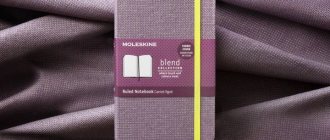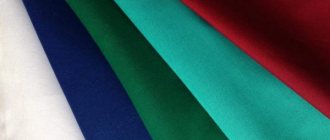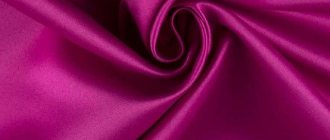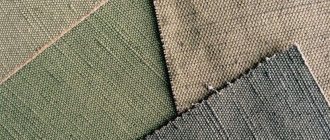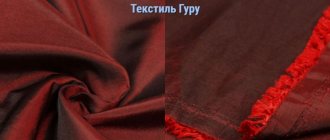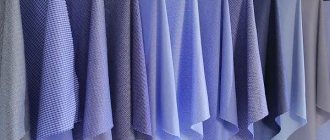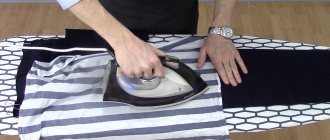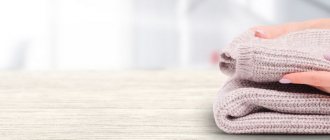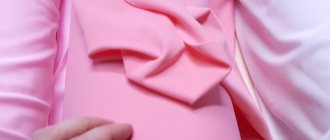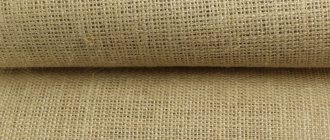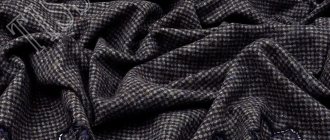Description and composition
Polyviscose, what kind of fabric is it, natural or not? Polyviscose fabric contains a percentage of natural viscose and synthetic polyester - hence the name.
Polyester and viscose - what are these fabrics?
- Viscose is a fiber obtained from cellulose by processing wood, that is, a natural material obtained artificially.
- Polyester is a completely synthetic material obtained from oil refining, its melt.
Which is better, viscose or polyester? There cannot be a definite answer here, because each material has its own pros and cons. Viscose is environmentally friendly, breathable and absorbs water, and polyester is a very strong and wear-resistant material.
Polyviscose contains viscose, polyester and, sometimes, elastane in different proportions; now we’ll figure out what kind of fabric it turns out.
- 70% polyester, 30% viscose - what kind of fabric is this? Depending on the manufacturing method, the material can look like silk, linen or even wool. Different types of material have several qualities in common - pleasant tactile sensations, strength and wear resistance.
- What kind of fabric is 30% viscose, 65% polyester, 5% elastane? The previous option has one, but very significant, disadvantage - it does not stretch well. Adding a small percentage of elastane allows the material to stretch well in different directions, which, in turn, sufficiently expands the range of its applications.
In general, the material can be described as follows: soft, delicate, shiny, flows and forms beautiful draperies.
Price – from 450 rubles.
Composition and production
Polyviscose is a mixed material consisting of 100% synthetic polyester and artificial viscose. Typically, the fabric composition is dominated by synthetics (60-70%), due to which the material is durable and wear-resistant. The most delicate viscose, made from wood cellulose, gives the fabric softness and breathability. But there is also fabric with the opposite composition: 70% viscose and 30% polyester.
Polyviscose with the addition of elastane (5%) has better stretch, is more durable and is excellent for sewing casual clothes.
The weave of threads in polyviscose fabric can be very diverse: transverse, satin, twill. Therefore, this material is sometimes confused with natural cotton and linen. The surface can be matte or shiny.
If you still doubted what kind of fabric polyviscose is and whether it is natural or not, now you know for sure: it is a mixed material that combines synthetics and artificial fiber.
Properties
It is the composition that determines the properties of this matter.
Advantages:
- Good breathability and hygroscopicity (natural viscose has twice the hygroscopicity of cotton)
- Does not cause allergic reactions
- The material is very easy to care for
- Soft, lightweight and pleasant to the body material provides high wearing comfort
- High resistance to wear, abrasions, tears
- The addition of elastane ensures that the product will keep its shape perfectly - stretch and return to its original state.
- Does not stretch on elbows and knees
- Forms very beautiful draperies and folds
- Does not accumulate static electricity
- Doesn't wrinkle
- Not expensive
The disadvantages include the fact that over time, pellets may form on the product. Our expert will tell you how to remove chewing gum stains from jeans.
Properties and applications of polyviscose
The fabric is easy to care for, easy to wash, and does not cause allergic reactions.
The modern consumer is well aware that many products are produced synthetically or artificially - it is cheaper and faster than processing and growing natural materials. However, you should not be afraid of the presence of chemically created threads in polyviscose - they only improve the quality of organic fibers.
Positive properties of the fabric:
- high breathability and hygroscopicity - the material allows air to pass through and does not allow moisture to accumulate on the skin;
- hygiene and safety – the fabric is easy to care for, easy to wash, does not cause allergic reactions;
- lightness and softness - comfortable, pleasant to the touch material does not restrict movement and at the same time fits tightly to the skin;
- wear resistance and elasticity - the material resists tearing, stretches and returns to its original proportions;
- shape stability - does not stretch on the elbows or knees, drapes well and forms soft folds;
- affordable price;
- the fabric is not electrified.
This material has practically no disadvantages. However, it happens that over time, polyviscose begins to pill; the pellets are removed with a special machine.
They sew from polyviscose:
- school uniform;
- classic office suits;
- blouses, dresses, skirts, trousers;
- children's clothing;
- jackets and coats;
- lining for outerwear;
- household textiles (curtains, tablecloths, sleeping sets);
- cleaning wipes;
- carpets.
Application
How do polyester and viscose combine in clothing? They complement each other perfectly. The following are produced from polyviscose:
- Casual clothes (skirts, trousers, dresses, shirts)
- Formal clothing (office suits, school uniforms)
- Children's clothing
- Outerwear
- Lining
- Home interior textiles (curtains, tablecloths, bedspreads, bed linen)
- And even carpeting
We will try to tell you in the article how to wash a white bra by hand so that it becomes like new.
What is it used for?
Polyviscose has found use in the manufacture of various clothes due to the variety of textures:
- Business suits and school uniforms;
- trousers, skirts, dresses and shirts for everyday wear;
- many types of children's clothing;
- outerwear for adults and children made of dense and thick types of fabric;
- home textiles: bedspreads, curtains, tablecloths and bed linen;
- as a comfortable lining material.
Polyviscose fiber is used in carpet production. The resulting coatings are attractive in quality, softness and easy cleaning.
Care
Caring for polyviscose products is quite simple:
- Before washing, turn the item inside out and fasten all the zippers - this will prevent puffs from forming on the item
- Wash by hand or in the washing machine on delicate cycle
- Water temperature - no higher than 30 degrees, aggressive detergents are prohibited
- Be careful with the spin cycle - do not twist the product, it is better to get it wet
- Drying - on a horizontal surface, away from heating devices
- Storage – folded
Caring for polyviscose products
Read about: cotton fabric with elastane: a combination of naturalness and functionality.
Products made from this blended fabric are easy to clean; you just need to follow the instructions on the label of the specific product.
Before washing, the product must be turned inside out and washed separately from items made from coarser materials. You can wash it manually or in an automatic machine on the “delicate fabrics” cycle. Do not use aggressive powders or chlorine-containing bleaches.
It is better to dry it flat out in a horizontal position, spread on a clean towel, away from radiators.
You can iron polyviscose if necessary, but usually only the seams require this, since it wrinkles a little. It also all depends on how much polyester is in the composition - the more of it, the lower the temperature of the iron should be, since synthetic fibers are destroyed under the influence of high temperatures. Ironing is possible from the inside out; the product must be dry.
On a note
It happens that pellets form on the surface of products in places most susceptible to friction (the shoulder and lower side of dresses and suits often come into contact with bags), and the overall appearance becomes untidy. In this case, there are special devices for removing them, after which the product is like new again.
Whatever polyviscose wardrobe item you choose, you can be sure that it will be comfortable to wear and, with proper care, will last a very long time.
Reviews
Yulia, 35 years old “My office suit is made of polyviscose. In principle, I'm satisfied. The material hardly wrinkles - that is, it always has a neat appearance. The body in the suit breathes - and this is also an important factor when you are indoors all day. This year my daughter will go to school, I think I’ll buy a school uniform from this material too.”
Tatyana, 32 years old “I bought a carpet made from this material, and now I laugh at the surprise of the guests - whether it is silk. The appearance of the product is indeed very attractive - shiny, cozy. And it’s quite easy to clean.”
Recommendations
Before washing a polyviscose item, it is advisable to turn it inside out. For this material it is better to use a delicate wash.
It is undesirable to use solutions containing chlorine, aggressive agents and bleaches when caring for polyviscose.
It is better not to wring out the item in the machine. This procedure must be carried out independently.
After cleaning, the item should be dried in a horizontal position on a soft towel. While drying, we recommend placing the product away from heating equipment.
Only seams can be ironed periodically. You cannot iron wet polyviscose items; it is better to wait until they dry.
Over time , pellets appear on the surface of the material, so they must be promptly removed using a special device.
The price of polyviscose is within affordable limits, so almost everyone can sew something for themselves from this material. The cost of good polyviscose starts from 800 rubles per meter.
